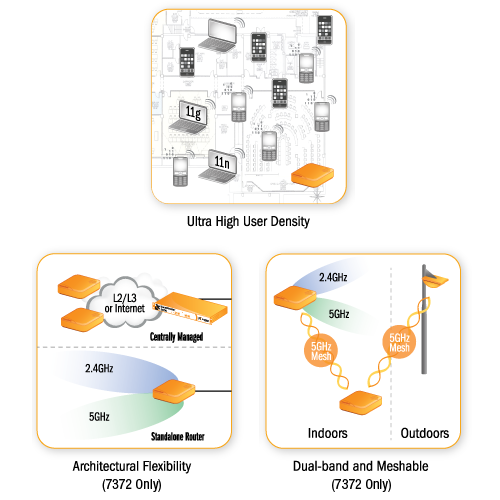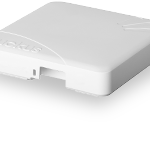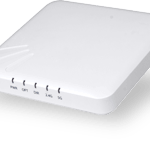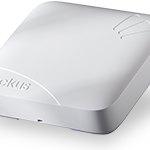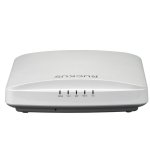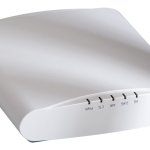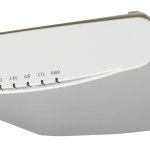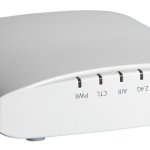The Industry’s Best Performing, Mobile-Ready, 2-Stream Access Points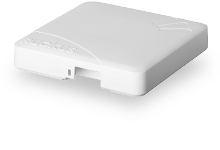
The next generation Ruckus ZoneFlex™ 7372 mid-range 802.11n 2×2:2 dual-band 2.4GHz and 5GHz concurrent access points are designed for high density mobile device environments with bandwidth hungry and latency sensitive applications such as Voice and Video over Wi-Fi. These APs boast Ruckus patented adaptive antennas enhanced with polarization diversity to deliver BeamFlex+. This technology works in conjunction with Ruckus’ advanced channel optimization to provide industry-leading wireless performance. BeamFlex+ combines dynamic polarization diversity with adaptive antenna arrays and transmit beamforming to give customers up to a 4x improvement in Wi-Fi performance, signal gain and reception.
With a theoretical throughput of 300Mbps per radio, the ZoneFlex 7372 ensures maximum throughput to three-stream capable clients while also improving single and dual-stream client performance.
Pervasive Performance
The ZoneFlex 7372 integrates a patented software-controlled adaptive antenna array that delivers additional signal gain per radio chain. As BeamFlex+ adapts to client locations and RF signal polarity, the smart antenna array transmit and receive on a per packet basis. This allows for up to 4x improvement in signal range and a reduction in packet loss. By combining BeamFlex+ with the transmit-based beamforming, the ZoneFlex 7372 is capable of delivering up to 4dB of transmission gain.
Dynamic Clients
In dynamic indoor and urban Wi-Fi environments, mobile device orientation constantly changes. This affects the polarization of the transmissions. Traditional Wi-Fi antennas are static in nature and only listen using one polarization. This prevents them from capturing the full signal from mobile client devices. The Ruckus 7372 listens in all polarizations simultaneously. This results in over 2x (4dB) gain to mobile devices with weak transmitters.

- Two-stream MIMO 2×2:2
- ZoneFlex 7372 – Concurrent dual-band support
- ZoneFlex 7352 – Single-band (2.4 GHz) support
- Up to 300 Mbps of user throughput and 128 unique antenna patterns per band
- Up to 4dB of signal-to-interference and noise (SINR) improvement and up to 15dB of interference mitigation
- BeamFlex+ and Transmit beamforming capable
- Capable of supporting over 500 clients per ZF7372 AP
- Novel channel selection approach delivering up to 50 percent capacity gain over alternative background scanning approaches
Adaptive antenna arrays and Automatic interference mitigation
- Up to 4 times extended range and coverage
- Automatic interference mitigation, optimized for high-density environments
- BeamFlex+ combines dynamic polarization diversity with adaptive antenna arrays and transmit beamforming
Concurrent support for HD IPTV, VoIP and data
- Support for isochronous, multicast IP video streaming
- Four queues per client station
Smart meshing increases flexibility, reduces costs
- Smart Mesh Networking
- Admission control/load balancing
Differentiated services with multiple SSIDs
- 27 BSSIDs with unique QoS and security policies
- WEP, WPA-PSK (AES), 802.1X support
- Zero-IT and Dynamic PSK
- Smartmesh Networking
- Captive portal and guest accounts
- RADIUS and Active Directory support
Diagram :
Specification :
| Power |
|
| Physical Size |
|
| Weight |
|
| Ethernet Ports |
|
| Lock Options |
|
| Environmental Conditions |
|
| Power Draw |
|
| RF (7372 Only) | |
|---|---|
| Antenna |
|
| Physical Antenna Gain |
|
| BeamFlex+* SINR TX Gain |
|
| BeamFlex+* SINR RX Gain |
|
| Interference Mitigation |
|
| Minimum RX Sensitivity |
|
| Performance and Capacity | |
|---|---|
| UDP Throughput (7372) |
|
| Concurrent Stations |
|
| Simultaneous VoIP Clients |
|
| Management | |
|---|---|
| Deployment Options |
|
| Configuration |
|
| Auto AP Software Updates |
|
| Wi-Fi | |
|---|---|
| Standards |
|
| Supported Data Rates |
|
| Radio Chains |
|
| Spatial Streams |
|
| RF Power Output** |
|
| Frequency Band |
|
| Frequency Band |
|
| BSSID |
|
| Power Save |
|
| Wireless Security |
|
| Certifications |
|

